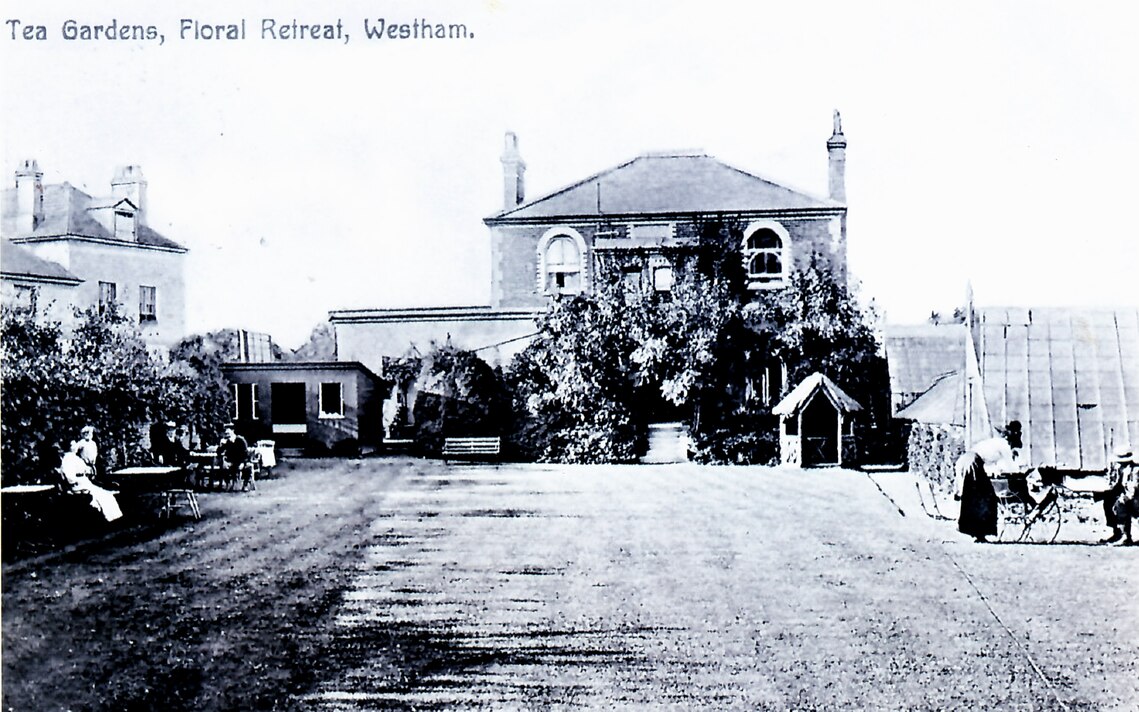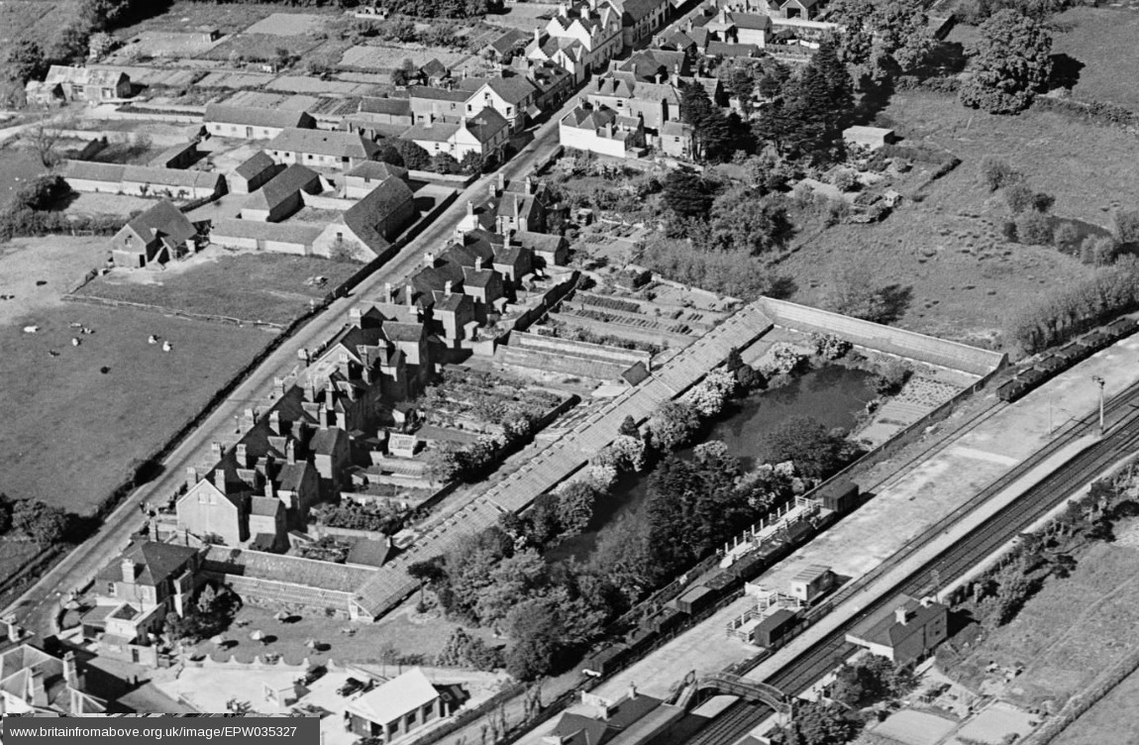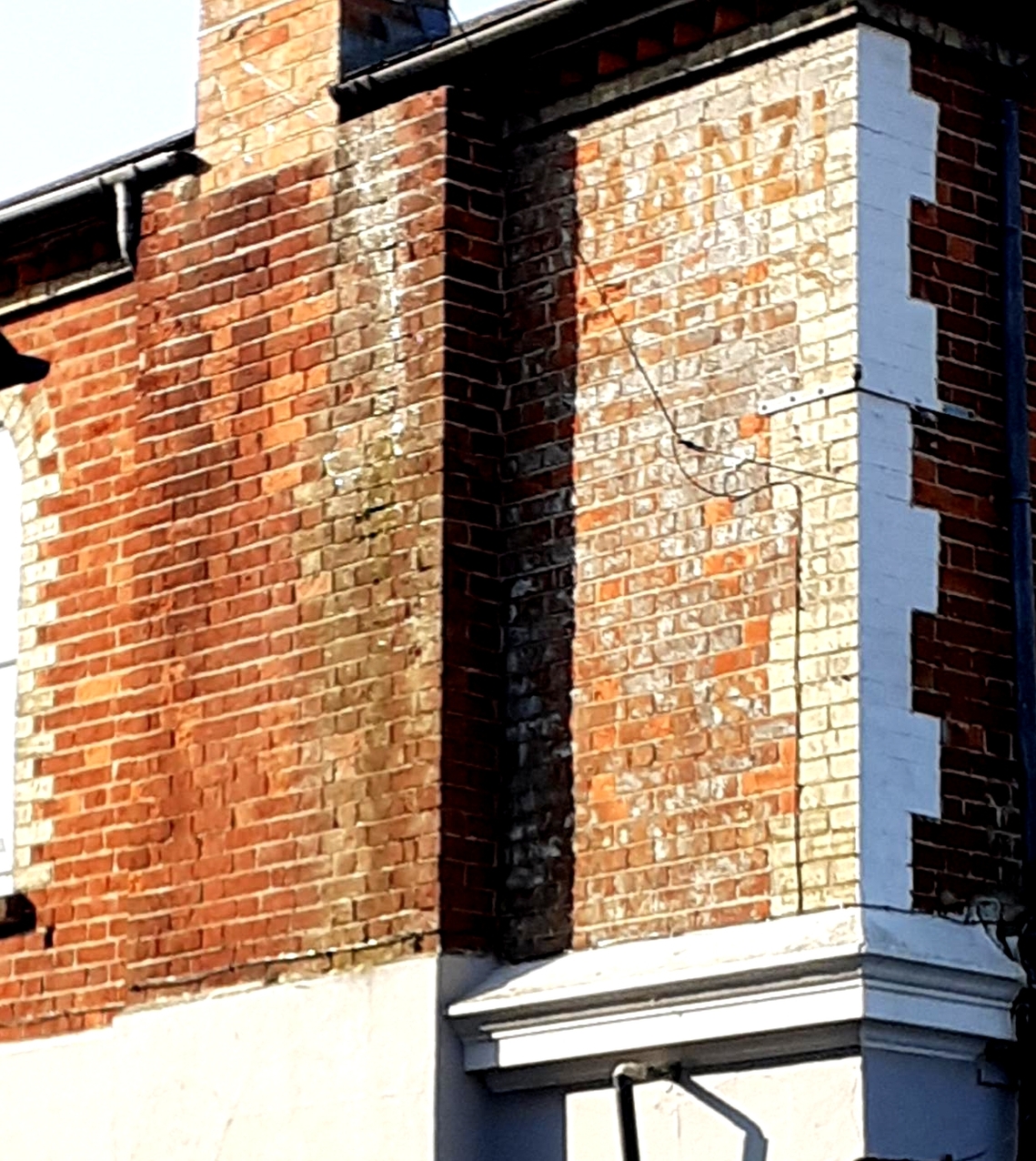Stepping out of Pevensey and Westham Station, you walk into Westham, the old village to the west of Pevensey Castle. Next to the station, the environment is much more recent : there is a repair garage, a Southern Water pumping station and modern houses in orange brick – lots of modern houses.
From the 1880s to the 1920s, the land in front of the station was the site of The Pevensey Pleasure Grounds and Floral Retreat. This consisted of a large square house (now a restaurant and excellent fish-and-chip shop) and two acres: a large lawn plus an ornamental lake, all surrounded by greenhouses. A 1931 aerial photograph shows the garden.
The Floral Retreat, with its ornamental lake, in 1931. The railway station is bottom right. © Britain from Above
When the railway station was built in 1846, it was situated in open fields, a quarter of a mile from the village of Westham. Many of these fields, from the village to the station, were owned by Jesse Dann, a local brickmaker and market gardener. Much of the site was shown in the 1875 OS map as ‘brick fields’ and there were two ponds. The ponds were a consequence of brick-making. Digging out brick-earth leaves large hollows in the ground, and they fill up with water. To counter this, Mr Dann acquired a wooden windpump. The pump survived, astonishingly, and is now at the Weald and Downlands Museum in Singleton.
By the 1880s, Jesse Dann was describing himself as a builder: quite rightly, as he had built a fair part of Westham’s new High Street. His sturdy Victorian houses were built just yards away from the brickfields.The first house on the High Street, closest to the station, was the home of the Pleasure Ground. It was a family home which also offered teas and was the centre of a market gardening business. There were extensive greenhouses and the Dann family would exhibit ferns, grapes and other fruits locally. Most importantly, it had a lake. Many Sussex gardens owe their lakes to the iron industry, and a brick pond is another instance of a garden designer’s opportunism.
A newspaper of 1888 reports:
the neighbourhood of the station has been much improved within the last three or four years by the conversion of what was a used brickfield into a pleasure resort, named the Floral Retreat, and this is no misnomer for the grounds are well laid out, both, with conservatories and also for open-air display, the principal hollow being utilized as an artificial lake, said to be stocked with fish.
The same newspaper suggests that a trip out to Pevensey and Westham offered a relief from the ‘painfully stiff’ social world of an Eastbourne holiday.
In 1886 the Pleasure Garden, run by Jesse’s son Frederick, could boast ‘Croquet and Tennis Lawns, an Angling Lake, Grapes, Fruits and Other Flowers’. It had an excellent train service. The train companies had positioned the Pevensey and Westham station with an eye to the tourist business. Visitors from Eastbourne or Hastings could walk to the Castle and have tea at the Garden while they waited for the train home. Visitors could buy grapes, peaches, tomatoes and cucumbers, as well as bouquets cut to order. The house also had furnished apartments to be rented.
A decade or two later, in 1901, it was advertised as ‘The Floral Retreat – Pevensey Pleasure and Tea Gardens’. It provided Vineries and Greenhouses, Tennis Lawn, Bowling Green and Angling. It offered ‘good accommodation for Young Ladies’ Schools and Cyclists’. The main event of a summer afternoon was a ’strawberry tea‘, provided by the young Mr. and Mrs. Dann.
Jesse Dann was an important figure locally. In the election of 1886, the local Conservative leader Captain Taylor, had used a gang of rowdies to disrupt a Liberal meeting at the Royal Oak in Pevensey. Jesse Dann invited the Liberals to use the Floral Retreat, where the ornamental lake proved its worth. The Conservatives began to cause trouble. But after it was made evident that ‘no nonsense would be tolerated, and an intimation given that the pond would be brought into requisition, excellent order prevailed.’ In 1894 the Retreat also welcomed the Eastbourne Women’s Liberal Association, whose members enjoyed the beautiful weather while the gardens were looking at their best. They were able to discuss the provision of police matrons and the success of female voting in New Zealand.
The Retreat was a commercial venture, and any possibility was explored (except on Sundays). In the winter, the lake was advertised as a safe skating rink; in the January evenings of 1901 the lake was illuminated at night with Chinese lanterns, lamps and torches.
The main evening entertainments were, of course, in the summer. The Chinese lanterns would be brought out, and on some balmy evenings there was a full moon. Music was provided: sometimes there might be simply a piano, or possibly a string quartet or a small military band. On 5th June 1901, members of the Eastbourne Cycling Club gathered at the Floral Retreat at 5 p.m. They were joined by cyclists from Hastings, Lewes and Bexhill, a total of 180 people. ‘Couples strolled round the little bye-paths which intersect the grounds. And as twilight gently spread its wings, the graceful movement of the swans swimming on the lake were greatly admired’. There was dancing until 11pm. In summer the garden would have a series of evening ‘lawn dances’.
The Great War ended most of this. Post-war, the Floral Retreat became known as The Gondola, with boating on the lake. A garage – known at one point as the Gondola garage – was opened next to the garden, as was a small sewage pumping station.
The last reported season of lawn dances seems to have been in 1914. On 24th June 1914 – just as Archduke Ferdinand was heading towards Sarajevo – this advert appeared.
LAWN DANCES
Are being held at the FLORAL RETREAT, WESTHAM, PEVENSEY
NEXT DANCE WEDNESDAY June 24, and every fortnight, weather permitting.
Dancing 7.30 to 11 o’clock Admission 6d
The garden is gone and only the house remains: it holds one mysterious vestige of the past. On its upper eastern wall, the traces of an old painted name are still visible, at certain times of day: AMANZI NURSERIES.
The nurseries we know about, but Amanzi? It is, according to the internet, the Zulu word for water. Which, if anything, makes the mystery deeper.



